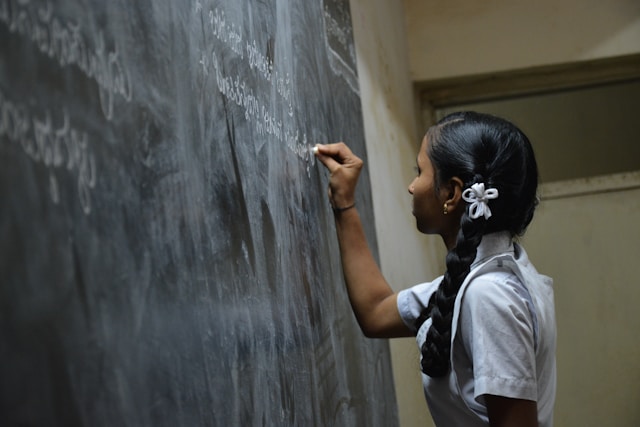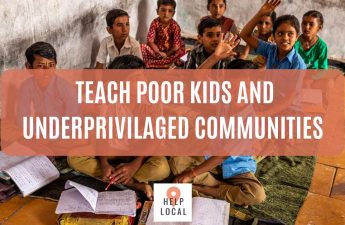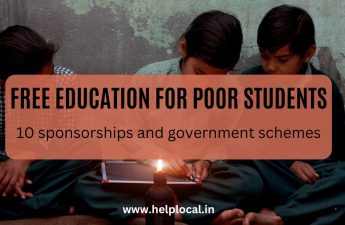Every child deserves a chance to learn, grow, and dream big – no matter where they come from. The Right to Education (RTE) Act says exactly that. It opens the doors to quality education for thousands of children across India by providing free admission in private schools.
Suppose you are a parent wondering how to apply. In that case, what documents you will need or whether your child is eligible, don’t worry – in this blog, Helplocal – trusted to find NGOs in India – will explain everything you need to know about RTE admissions in a simple and friendly way.
Note: The Right to Education (RTE) Act aims to ensure free and compulsory education for children between the ages of 6 and 14.
What is RTE Act?
The Right to Education Act, introduced in 2009, is a law that guarantees free and compulsory education for all children between the ages of 6 and 14 in India.
One of its most important features is that 25% of seats in private schools are reserved for children from economically weaker sections (EWS) and disadvantaged groups, giving them an equal opportunity to learn in a better environment.
Why is RTE Admission Important?
Let’s be honest – private school education can be expensive. However, with RTE admission, your child can attend a good private school completely free of cost.
It’s not just about saving money. It’s about giving your child the opportunity to learn, grow confidently, and build a bright future.

Recommended reading:
Free education for poor students
Medical help for poor in India
Who can apply for RTE Admission?
Here’s a quick look at who’s eligible:
Age: Children between 6 and 14 years of age.
Income: The family must fall under the economically weaker section (EWS) as defined by your state.
Category: Children from SC, ST, OBC, minority communities, or children with disabilities.
Residence: In most states, you will need to apply to schools closest to your home (within a certain distance or “neighbourhood limit”).
Documents for RTE admission
To complete your RTE admission application, you will need:
Your child’s birth certificate
Proof of address (such as Aadhaar card, ration card, or electricity bill)
Income certificate of the parent or guardian
Caste certificate (if applicable)
A passport-size photo of your child
Disability certificate (if applicable)
Make sure all your documents are clear, valid, and up to date.
How to Apply for RTE Admission (Step-by-Step)
Applying for RTE is easier than you think! Most states allow you to do it online: Visit your state’s RTE website Each state has its own official portal (for example: rte.raj.nic.in or rte25admission.maharashtra.gov.in).
Register online: Sign up using your mobile number and fill in basic details. Fill in the application form. Add your child’s details, upload your documents, and choose nearby schools.
Submit the form and save the confirmation: After submitting, you’ll get a reference number to track your application. Wait for lottery results. If more students apply than there are available seats, a lottery system is used. Selected applicants will be notified by SMS or email.
Useful tips for parents: Keep checking the RTE portal regularly for updates and deadlines. Apply as early as possible – don’t wait until the last day. Choose multiple schools to increase your chances. Save all confirmation pages and screenshots.
How does RTE make a difference?
Thousands of children have already benefited from RTE admissions. It’s more than just getting admission in a private school – it’s about being part of a system that believes in equal opportunities.
The Act helps reduce social gaps, boosts confidence in children, and supports families who dream of a better life for their children.
The RTE admission process is a golden opportunity for families who want their children to receive quality education without any financial stress. By understanding the process, getting your documents ready, and applying on time, you can give your child the start they deserve.
After all, every child deserves a classroom where they can learn, grow, and shine – and RTE makes this possible.

Right to Education: Admission FAQs
Q. Is RTE admission really free?
Yes! It includes tuition fees, books, and even uniforms in most cases.
Q. Can I apply offline?
Most states prefer online applications, but some offer offline options as well. Q. How are children selected?
If there are more applications than seats, schools use a lottery system to select students fairly.
Q. Can I apply to more than one school?
Yes, and in fact it is recommended to increase the chances of selection.
Right to Education Act: Wrapup
If your child is eligible, don’t miss this opportunity. Visit your state’s RTE website, apply on time, and give your child a chance to study in a school where dreams take flight. If you or someone you know needs education but worries about the cost, don’t lose hope. Help is available! You just need to take the first step. Feel free to share this guide. Who knows, it could change someone’s life.
Looking for NGOs near you? Browse Helplocal India to discover nonprofits you can donate to or support. Want to partner with other NGOs in your state?
Check out these state-based NGO blogs:



